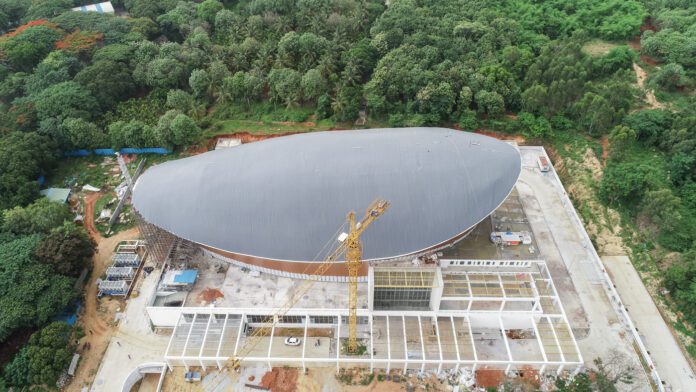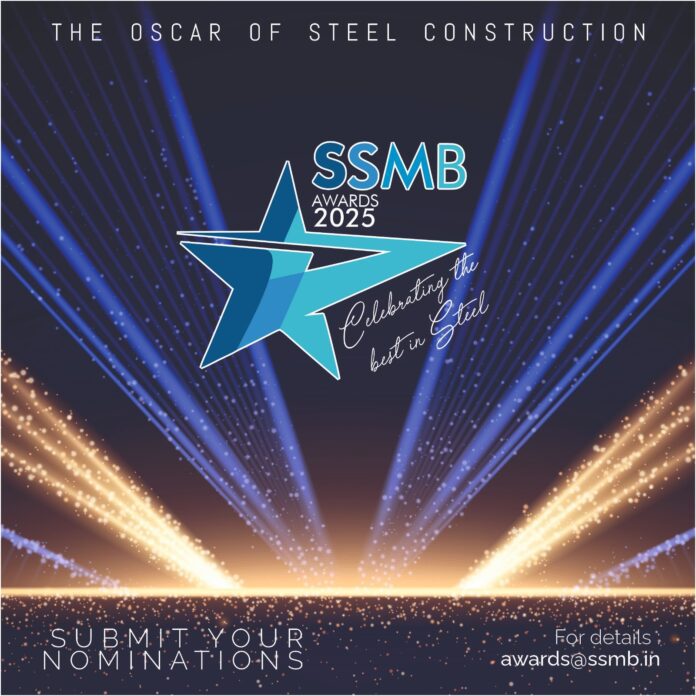Introduction: When a civic project dares to push beyond the ordinary, it leaves behind more than a building. It creates a landmark. Bengaluru’s Babu Jagjivanram Auditorium & Convention Centre, designed by DSP Design Associates, is one such marvel. With a sweeping 106.6 m steel space-frame roof, a column-free 50 m wide auditorium, and a record 18-month construction timeline, this government-commissioned project combines ideology, engineering daring, and architectural boldness in a way that demands attention. It is at once a stage for civic dialogue and an engineering spectacle that bends steel into an unforgettable form.
The brief for this project was unusual in its scope. It was not only to house a research institute for civil services aspirants but also to create a public auditorium for government and cultural gatherings. The ideological undercurrent drew from the vision of Dr. Babu Jagjivan Ram, who stood for inclusivity and accessibility. DSP Design translated this philosophy into a form that was at once civic, cultural, and symbolic. An architectural beacon rising from a challenging sloping site, with a forecourt that doubles as public open space.
THE DRAMA OF SCALE AND STRUCTURE
What makes this project a true MindBoggler is its scale. The auditorium demanded massive column-free spans that few conventional systems could deliver. The answer lay in steel: a space-frame system spanning over 100 m in length and 50 m in width, weighing only 300 tonnes. Supported by 1.6 m deep peripheral beams, the roof shell hovers like a sculptural canopy, seemingly light yet structurally formidable. This audacious engineering decision transformed the project into one of the largest-span civic roofs in Karnataka.
SPANNING THE IMPOSSIBLE
The biggest challenge in a project of this magnitude was not just scale but structural stability without compromise. A span of 106.6 m demands meticulous control over deflection, load transfer, and dynamic behaviour. The team had to ensure that the roof could withstand wind pressures, live loads, and acoustic vibrations, while maintaining the sanctity of the interior volumes.
The solution came in the form of a lightweight yet powerful steel spaceframe, precisely engineered to handle loads across its lattice geometry. Here, steel’s adaptability was the true hero, offering both strength and modular flexibility. By coordinating closely with structural consultants, DSP Design ensured that the load paths remained efficient, while the assembly remained practical for on-site construction. In the end, the fusion of digital modelling, structural analysis, and material efficiency transformed what seemed impossible into a reality.
“The 106 m span was not a challenge to be solved, but an opportunity to prove steel’s unmatched potential.”
OVERCOMING THE SITE AND THE CITY
The site in Beggars’ Colony came with its own complexity with a 10 m natural slope, urban road networks, and traffic flows. Instead of fighting it, the design team turned the slope into an advantage, perching the main structure at the rear while freeing the frontage for landscaping and public access. The result is a building that not only dominates its setting but also engages the city, standing visible from arterial highways and reinforcing its civic identity.
ACOUSTIC STRATEGIES
A large auditorium is only as good as its sound. The challenge here was to marry structural daring with acoustic perfection. While the steel spaceframe carried the loads, it could not be allowed to interfere with sound quality. To address this, the design incorporated insulated roofing systems, multi-layered façades, and sound-absorbing interior panels.
The ceiling systems were acoustically isolated to prevent vibrations from the steel frame from echoing through the space. HVAC systems were mounted with vibration dampeners, ensuring that mechanical noise did not compromise performances. Every material from wall cladding to seating upholstery was selected to contribute to a balanced acoustic environment.
The outcome is a hall that not only looks monumental but also performs acoustically with finesse that is equally suited to a spirited debate, a musical recital, or a government address.
“Behind the drama of steel lies the quiet science of sound — invisible, but vital to the experience.”
CONSTRUCTION STORY
Delivering a project of this complexity required a construction strategy as bold as its design. The project team prioritised prefabrication and modularity from the outset. Roof components were fabricated in controlled factory settings, where quality and precision could be tightly managed.
Each segment of the space-frame roof was manufactured off-site, transported to Bengaluru, and then lifted into position with high-capacity cranes. The modular design allowed for seamless on-site assembly, reducing congestion on the tight urban site and minimising construction risk.
Meanwhile, the RCC podium was executed in phases, allowing the structural base and roof assembly to progress in parallel. This overlap of civil works and steel erection dramatically shortened the project schedule. Digital parametric models guided the process, ensuring that every connection aligned perfectly once the modules arrived on site.
The result was nothing short of astonishing: a structure that should have taken 36 months, delivered in just 18 months. For a public-sector project in India, this pace was unprecedented, and it showcased how steel’s prefabrication advantage can revolutionise timelines in civic infrastructure.
ENGINEERING FIRSTS AND SPEED RECORDS
The Babu Jagjivanram Auditorium represents several “firsts” in Karnataka’s civic infrastructure. It is among the first government buildings in the state to boast a 106 m span space-frame roof. Its timeline halved through modular execution, sets a benchmark that challenges the stereotype of sluggish public projects. And in using only 300 MT of steel for a span of this magnitude, it redefines the conversation around material efficiency in large-scale construction.
A LANDMARK FOR BENGALURU’S CIVIC FABRIC
Beyond its technical feats, the Babu Jagjivanram Auditorium is a statement of intent. With a seating capacity of 1,800 and a programme that spans education, public dialogue, and cultural performance, it is designed to bring people together. Its sweeping roof and sculptural form grant it landmark status, but its true value lies in its function: a space that supports civic discourse, nurtures aspirants, and anchors its neighbourhood with pride. In its scale, symbolism, and execution, it demonstrates how public architecture can transcend utility to become a stage for society itself.
Editor’s Note
The Babu Jagjivanram Auditorium and Convention Centre, more than a building, is a manifesto in steel. With its daring spans, civic purpose, and record-setting speed, it sets new expectations for what government projects can achieve. This is engineering as drama, architecture as ideology, and steel as poetry in motion.
Architect’s Voice:
“The essence of this project lies in its ability to merge ideology with engineering. We wanted to create a civic space that not only serves its purpose but also inspires, a place where scale, speed, and symbolism come together in steel.”
ASHISH JAUHRI, Principal Architect, DSP Design Associates
Why This Project is a MindBoggler
- Span of 106.6 m — one of the largest civic roofs in Karnataka
- Column-free auditorium of 50 m width
- Completed in 18 months, half the typical timeline
- Steel efficiency at 300 MT
- Dual function: public auditorium + civil services institute
FACT FILE
- Client: Government of Karnataka
- Architect & Project Manager: DSP Design Associates Pvt Ltd
- Structural Consultant: Cruthi Consultants
- PMC: Karnataka Residential Education Institutions Society (K.R.E.I.S)
- Contractor: NCC Limited
- Steel Fabricator/Supplier: Metal Karma
- Tonnage: 310 MT
- Status: Completed




